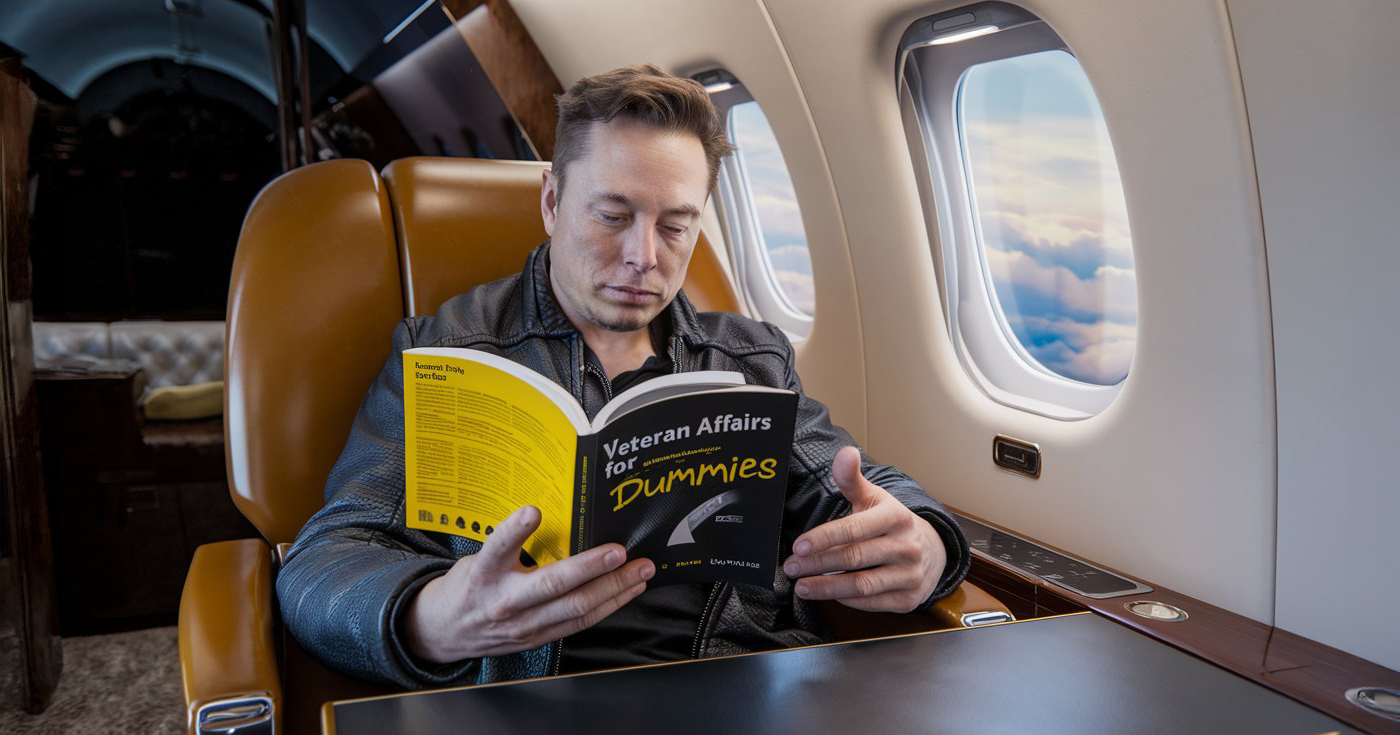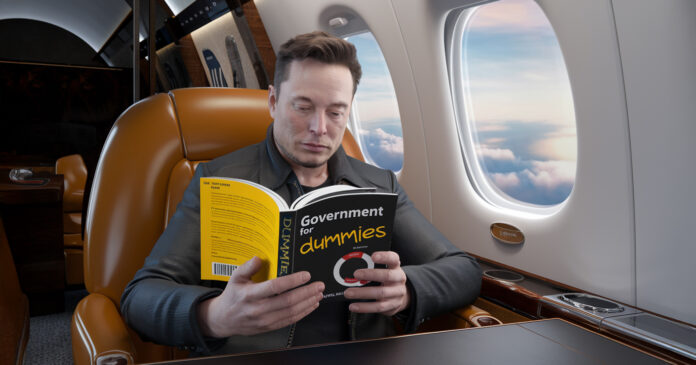Editor’s note: Loretta Splitair is currently seeking asylum in an undisclosed non-Musk-owned jurisdiction. Follow her on X until she, too, is replaced by AI.
Washington, D.C. — Somewhere at 40,000 feet, in a Gulfstream jet hastily rebranded as X-1, Elon Musk sits with furrowed brows, flipping frantically through a copy of Government for Dummies. His leather-jacket-clad frame is hunched over the pages, lips moving as he tries to make sense of terms like separation of powers and bureaucracy.
This last-minute crash course in Civics 101 comes after Musk’s surprise takeover of the United States government, a move made possible through a mix of Twitter polls, crypto-backed buyouts, and an extremely confused Supreme Court decision that no one fully understands but was somehow voted on with a fire emoji.
Musk, who declared himself Supreme Technocrat of the USA (or “XSA” as he prefers), initially celebrated the acquisition, calling it “the biggest merger and acquisition deal in human history” and promising that government, much like Twitter, would be radically streamlined for efficiency. But as the first few days of his rule unfolded, it became painfully obvious that Musk may not have fully thought this one through.
‘Wait, So I Can’t Just Fire the Senate?’
On his first official day in power, Musk entered the White House—renamed “X HQ”—and immediately attempted to fire half of Congress, declaring them “non-essential employees” who would be replaced by a more agile, high-performance team of engineers. When informed that this was not, in fact, legal, Musk was visibly perplexed.
“Wait, what do you mean I can’t just fire the Senate?” he reportedly asked. “Like… legally?”
Aides attempted to explain the concept of checks and balances, but Musk, still flipping through Government for Dummies, dismissed the idea as “outdated legacy code” and instructed his remaining staff to “move fast and optimize governance” by implementing his new DOGE (Decentralized Optimized Government Experiment) Initiative.
DOGE, as it turns out, was essentially a chaotic mix of blockchain-based voting, an AI-driven judiciary, and the immediate rebranding of NASA into “SpaceX Public Edition.” The initiative was supposed to “revolutionize” the way government functioned. Instead, within 48 hours, it had resulted in:
The accidental abolition of the Department of Labor (deemed “redundant” since “real workers hustle harder”).
The privatization of Social Security, now offered as a premium subscription service under the name “Teslaretirement+” ($99/month for the basic plan, $149 for “verified retirees”).
A nationwide constitutional update, which was supposed to streamline legal inefficiencies but somehow left all judicial rulings up to Twitter polls.
As the chaos unfolded, Musk could be seen speed-reading the Dummies book between emergency briefings, nodding solemnly as he reached chapters like “Why Laws Exist” and “The Federal Reserve: Not Just a Fancy ATM.”
The ‘Beta Test’ Approach to Governance
Realizing that he may have been in over his head, Musk pivoted to what he knows best: beta testing.
“All of government’s problems are just a UI issue,” Musk said in a live-streamed town hall (mandatory viewing for all citizens). “So what if we just… launched a beta version first?”
Thus was born Government 2.0, an experimental governance system where new laws would be tested for 30 days before full deployment. Like a buggy software patch, some would stay, and some—if they resulted in too many lawsuits—would be quietly rolled back.
To prove the effectiveness of the model, Musk ordered a full reset of the Department of Education, replacing it with an AI-powered chatbot that generates “educational vibes” based on engagement metrics. Three days later, students attempting to log into their virtual classrooms were met with a 404 error and a looping GIF of Musk winking.
Meanwhile, the U.S. military was put on a Neuralink waitlist, and national parks were sold as NFTs, with Yosemite fetching the highest bid from an anonymous Ethereum whale.
A Nation Holds Its Breath as Musk ‘Learns in Real-Time’
As government agencies scrambled to adapt, Musk’s reading list expanded. In addition to Government for Dummies, aides reported seeing him flipping through Veterans Affairs for Dummies, Infrastructure for Dummies, and a well-worn secondhand copy of The U.S. Constitution Cliff Notes Edition, which he allegedly tried to return after realizing it wasn’t “open-source.”

“It’s actually wild how many rules there are,” Musk admitted in an impromptu X Spaces discussion. “Like, I’m just learning about this thing called due process? Why hasn’t anyone disrupted that yet?”
At press time, Musk was considering “unlocking additional governance features” through a national $8/month verification fee. Meanwhile, the people of Nevada have been placed into a “small-scale” beta test for an experimental government update, with no clear timeline for when—or if—it will be reversed.
As for the rest of America, all they can do is hope that Musk eventually gets bored and moves on to his next project. Rumors suggest he’s already eyeing Terraforming Mars for Dummies.
Until then, buckle up. And if you experience any issues with the new government, please open a support ticket at support.x.gov (response times may vary)

